Composting Toilets: A Review of Their Use In Public Venues in the U.S.†
Table of contents:
Introduction
Mention “composting toilet”, and most people will think of something suitable for a summer cabin or a rural residence off the grid—a kind of classy outhouse—surely not something suitable for installation in an urban environment. As one person has remarked, flush toilets are the accepted social standard. The idea of collecting human excrement in a basement composting bin does not exactly square with the modern paradigm of gracious living.
There is, however, more to the story. In what follows, we describe six composting toilet installations of varying types, currently installed for public use in locations in the United States, including three in California. We consider only those for institutional, industrial, municipal and commercial venues, i.e., those for which maintenance can be assured. We do not consider composting toilet installations for residential use.
In our descriptions, we include comments by administrators, architects and users. As we shall see, every one of these six installations is positively viewed. We also include a section on frequently asked questions, including discussions of costs and possible legal barriers.
Manufacturers: Clivus Multrum is the leader
A comprehensive list of manufacturers of composting toilets is available as a pdf that may be downloaded from the Sustainable Sanitation Alliance. Most of the manufacturers listed are located outside the United States, but among those listed are Clivus Multrum[1], located in Lawrence, Massachusetts, and the Phoenix Toilet, manufactured by Advanced Composting Systems LLC, located in Whitefish, Montana.
These two manufacturers produce toilets suitable for the non-residential venues we consider in this review, although Clivus Multrum is clearly the leader. (We are not aware of any Phoenix toilet installations in urban venues.) All the installations described below use toilets manufactured by Clivus Multrum. This company has gained a reputation for excellence of design and reliability, including the provision of reliable on-going maintenance contracts[2].
Buildings at the Vermont Law School
Oakes Hall
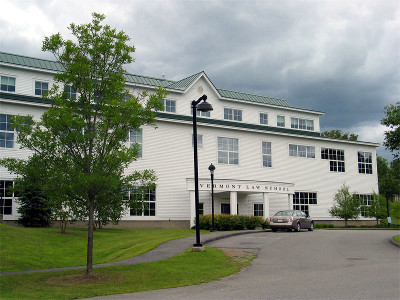
Oakes Hall
The Vermont Law School (VLS) is located in South Royalton, Vermont, a small community (population: 2900) in the valley of the White River. On the campus is Oakes Hall[3], a large three-story academic building, with many offices and classrooms. It is in use throughout the day, with as many as 300 occupants during peak periods.
Except for the toilets on the lowest level of the building, its toilets are composting toilets. Installed in 1998, they are clean, odor-free, quiet, obviously well-maintained, and are a delight to use.
The State of Vermont's Water Supply Rule states that the design flow criterion for such a building (without a cafeteria or gymnasium, but with the usual flush toilets) be 15 gallons per person per day, or 4500 gallons per day for a building with 300 occupants.
Oakes Hall actually uses 15½ gallons per day for the entire building, including water used for the bathroom sinks. Campus wide, Vermont Law School now uses less water than before adding this substantial building. Oakes Hall is the first public, year-round building in Vermont to make use of composting toilets.
There are several documents available that describe Oakes Hall, among which are these three:
- A document by Marc Rosenbaum, P.E., of energysmiths that describes the detailed engineering design of Oakes Hall, including its composting toilets. It is here.
- Here is a slide show that describes the building's environmental features, including (briefly, on slides 14 and 19) its composting toilets.
- Here is yet another description of Oakes Hall, this one by the Minnesota Sustainable Design Guides.
What motivated the Vermont Law School to consider composting toilets? A prime factor was the limited supply of available water. As summarized by Clivus New England:
Vermont Law School was planning to expand when it was faced with a water moratorium (VT Act 250) that would effectively halt construction of a new $3.25 million state-of-the-art 23,500-square-foot classroom building to house eight classrooms (510 seats), a mock courtroom, offices and student lounge.
Architects at Truex Cullins + Partners designed the building to meet US Green Building Council (USGBC) Leadership in Energy & Environmental Design (LEED) standards. They incorporated Clivus waste treatment systems with Nepon foam-flush toilets into the project. By redirecting restroom usage from adjacent buildings that were still utilizing traditional water-flushing toilets to the Clivus and Nepon toilets in the new building, campus water usage decreased overall. This allowed the school to enlarge its facilities while complying with the requirements of ACT 250.
Vermont Law School achieved USGBC LEED Silver Certification.
Debevoise Hall
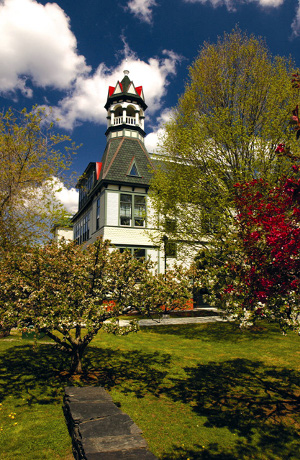
Debevoise Hall
In 2005, the law school, having experienced positive results with Oakes Hall, decided to install composting toilets in Debevoise Hall, the main Administration Building of the campus. The installation was part of an overall restoration of the building—an historic landmark for both the campus and the Town of South Royalton. The four-story building dates from 1893.
Here are some facts (quoted from the VLS website) about the composting toilets in that remodeled building:
- Composting toilets, which do not require any additional water, are on first two floors of Debevoise Hall. [They use] “foam flush”—a mixture of biocompatible soap and water which carries waste to the basement composting system, needing only six ounces of water per use.
- Aerobic bacteria will convert waste into potential fertilizer.
- The reduced water demand is a substantial benefit to the Town of Royalton's small, municipal water system.
- The building joins Vermont Law School's James L. and Evelena S. Oakes Hall as one of the first public, year-round buildings in Vermont to use composting toilets.
A campus opinion survey
In the Spring of 2010, the VLS Land Use Clinic—a student group at the VLS—conducted a survey about the composting toilets on the VLS campus. Here is a summary of their findings (quoted from a circulated flier):
- Vermont Law School students, faculty and staff support this back-to-basics technology. The Spring 2010 survey results show a positive impression.
- 44 percent make a conscious effort to use the composting toilets.
- 42 percent show them off to guests!
Additional comments
Two years ago, when we first were describing composting toilets installed at the Vermont Law School, Geoffrey Shields, then President of VLS, and Peg Elmer of the VLS faculty, wrote to us with these words:
“The water saving is amazing and the enthusiasm of students and guests to the campus is almost (not quite) universal.”
– Geoffrey Shields, President of VLS. February, 2011.“The students, faculty and staff appreciate them. Even better, the buildings crew here is clear that they have more trouble keeping the flush toilets on campus in working order. The VLS system was designed and is maintained by Clivus New England. They are quite proud of it — you'll find it and other public building examples of theirs on their website. They have been creative, having added red worms to some of the bins here to compare results, and having successfully designed a unique foam flush system for the long tubes serving the third floor. They have done a fair amount of testing of the compost.”
– Peg Elmer, Associate Director, Land Use Clinic, VLS. February, 2011.
Now, with our update, Marc Mihaly, the new President and Dean of VLS, added these comments:
“We love the toilets. They help convey to our students that we ‘walk the walk’. Also, most important, our maintenance staff swears by them. Very, very low maintenance.”
– Marc Mihaly, President and Dean of VLS. August, 2013.
The Bronx Zoo Eco-Restroom
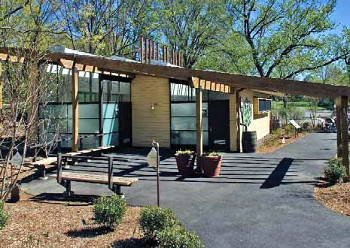
The Bronx Zoo Eco-Restroom
The Eco-Restroom at the Bronx Zoo stands at the Bronxdale entrance to the zoo, which receives more than half of the two million annual visitors to the zoo. Completed in 2006, it is not only a modern restroom, but an amazing educational experience, providing information to all users about this new technology.
Click on this link to view a fine video about the Bronx Zoo Eco-Restroom. If you do nothing else with this review, at least take a look at this one, put it in fullscreen mode and watch the show. It's a five-minute video.
Further details may be found on the Clivus Multrum website. Of special note is an article that appeared in Recreation Management Magazine in 2007. Just click on the “Facility Profile” link at the bottom of the page reached by the above link.
Here's one of the many laudatory comments:
“People's response to the new Eco-Restrooms has been overwhelmingly positive. The building is a pleasure to use, so I think the fear that some people might have going in that they're going to be faced with an ‘outhouse’ experience is quickly overcome. People ‘get it’…they come away realizing that a small change in behavior can result in a big change for the environment. Quite an accomplishment for a bathroom break!”
– Jon Dohlin, Project Manager, 2007.
The University of Vermont
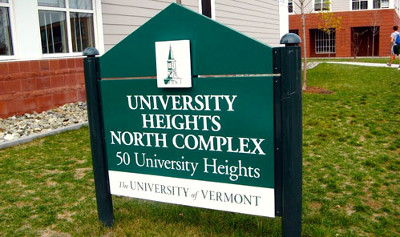
University Heights in Burlington, Vermont
The University Heights Student Residential Learning Complex, on the campus of the University of Vermont in Burlington, is a green learning and housing center, completed in 2006. Incorporated within the complex are classrooms, a student lounge, student union center, mailroom, and faculty offices. The University of Vermont aspires to protect the environment and educate students and visitors about preservation through the various sustainable technologies used in the construction of the complex.
In an effort to integrate the technology into the educational curriculum the Clivus composting waste treatment system is installed in a location that is visible and accessible to all visitors and students to learn about conservation and preservation at work.
Each semester there is an educational seminar with Clivus staff, UVM faculty, and students to discuss the water savings, land preservation, and pollution elimination provided by the Clivus and Nepon toilets. Students learn firsthand that the foam-flush toilets use up to 97% less water than traditional water flushing toilets, solid waste in the composting :system is reduced by 95% and emits just water and carbon dioxide, liquids from the composter are treated to become a higher quality, non-polluting discharge, and remaining wastewater from sinks and showers can be sent to much smaller soil absorption systems.
The complex has received the US Green Building Council Leadership in Energy & Environmental Design (USGBC LEED) rating of Gold. Further details are available from Clivus New England, and from the University of Vermont.
Installations in California
Although most of the installations of composting toilets by Clivus Multrum are situated in the Eastern U.S. and Canada, a few installations are on the West Coast in California. Three projects in particular—the last of which was completed in the Spring of 2014—are close to Santa Cruz. We describe them in what follows.
The Crystal Springs Golf Course
The Crystal Springs Golf Course, near Burlingame, California, installed two units in early 2010. Tim Powers, the Superintendent of the golf course, has this to say:
“Our players are very happy with them. They sure beat Port-O-Lets. They are connected to our irrigation system but use very little water. We have solar panels that power the batteries to run the fan and the foam in the toilet. It has been over 18 months on the first unit and we still haven't had to pump out the solids. We only spend about 5 minutes a day keeping them clean.”
The Crystal Springs Golf Course is also mentioned in a Clivus Multrum newsletter of March 12, 2012. The full story may be read here.
El Polín Spring, in the Presidio in San Francisco
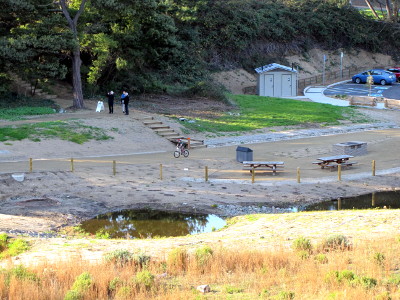
El Polín Spring
The restoration of the historic El Polín Spring in the Presidio was completed in 2011. Amy Deck, the Project Manager for this project, recently sent us these photos. The first one shows the spring in the foreground, with the M54 Double Trailhead unit in the background. The second one shows a closer view of the M54. She wrote these words:
“Public feedback has been very positive. We have very limited public facilities in the Presidio, so park users are very excited to have this amenity in the Presidio. Programmatically, it's great to be able to share our generation's layer of water usage/conservation efforts at this sensitive site that was initially settled due to water access at El Polín Spring.
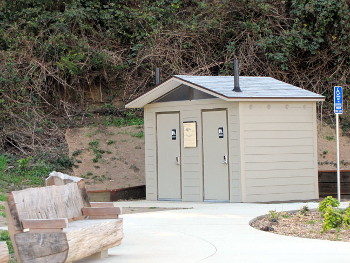
The M54 Double Trailhead Unit
The toilets are maintained quarterly by a subcontractor located in the East Bay for Clivus Multrum, which is very simple and quick. We do not have high enough usage that we have had to empty the vaults yet (installed October, 2011). The Presidio Trust is always looking to implement sustainable practices wherever possible, and this is a great example of our continued commitment to this effort.”
See this video for a description of El Polín Spring's other fascinating features and history.
Amy Deck also writes that
“In my composting toilet research, I went to visit Crystal Springs Golf Course in Burlingame. They have the foam type, but it was helpful to see nonetheless.”
Clivus Multrum has highlighted the El Polín Spring installation in their newsletter of July 23, 2013, noting that “The Clivus Multrum M54 Double Trailhead was selected as the restroom solution for the El Polín site because it provides the necessary capacity of up to 44,000 uses per year while accommodating the sensitive nature of the site.” Their full story may be found here.
The San Jose Environmental Innovation Center
The San Jose Environmental Innovation Center (SJEIC) involves an extensive and complex renovation of an existing 46,500 square foot building on a 4.2-acre property in central San Jose, located at 1608 Las Plumas Avenue.
The project, which has numerous environmental attributes, is being designed to achieve Leadership in Energy and Environmental Design (LEED) Silver certification, and may qualify for Gold or even Platinum certification.
Phase I construction, involving primarily exterior site improvements, was completed in June, 2010. Construction is now completed for Phase II. A ribbon cutting ceremony was held in May, 2014, and the building is now in use.
Composting toilets, which “will demonstrate an alternative method for reducing indoor water use”[4] are included in the project. Group 4 Architecture, Research + Planning, Inc.—located in South San Francisco—is the lead architectural firm designing the project. Jill Eyres of that firm wrote to us in June, 2013 that
“There will be one each in the women's and men's restrooms. Recently the hole was cut in the floor slab and the basement is being prepared for installation of the pit.”
This project is the first commercial project in California to incorporate composting toilets. A fact sheet that describes this project is here. Also, a recent piece appeared in the San Jose Mercury. You can read it right here.
Frequently asked questions
1. I've heard that composting toilets are not allowed in California. What's the deal?
There is no mention of “composting toilets” in the 2010 California Plumbing Code, nor are any similar fixtures listed as “prohibited”. Furthermore, in Chapter 3 of the Code (General Regulations), § 301.2 states:
“Alternate Materials and Methods of Construction Equivalency. Nothing in this code is intended to prevent the use of systems, methods, or devices of equivalent or superior quality, strength, fire resistance, effectiveness, durability, and safety over those prescribed by this code. Technical documentation shall be submitted to the Authority Having Jurisdiction to demonstrate equivalency. The Authority Having Jurisdiction shall have the authority to approve or disapprove the system, method or device for the intended purpose.”
Presumably this means, if a composting toilet is classified as an “Alternate Material and Method of Construction”, that while the California Plumbing Code does not prohibit the installation of composting toilets, a local jurisdiction, such as a city or county, does have the authority to “approve or disapprove” an installation of composting toilets.
Local officials, such as here in the City of Santa Cruz, may tend to rely on two other code sections, § 303.0 and § 304.0, and thus conclude that composting toilets are not allowed by state code. However, § 301.2 would seem to provide a feasible path to avoid invoking these sections, particularly for manufactured and assuredly maintained units.
These two sections state:[5]
“303.0 Disposal of Liquid Waste. It shall be unlawful for any person to cause, suffer, or permit the disposal of sewage, human excrement, or other liquid wastes, in any place or manner, except through and by means of an approved drainage system, installed and maintained in accordance with the provisions of this code.”
“304.0 Connections to Plumbing System Required. Plumbing fixtures, drains, appurtenances, and appliances, used to receive or discharge liquid wastes or sewage, shall be connected properly to the drainage system of the building or premises, in accordance with the requirements of this code.”
The Municipal Code for the City of Santa Cruz, while making no mention of composting toilets, does state, in § 6.12.140:
“COMPOSTING PERMITTED. Individual residents of the city of Santa Cruz may conduct home composting for the production of compost or mulch for other than commercial purposes or resale to the public. Composting techniques used shall be in accordance with good standard practices developed for the purposes of minimizing offensive odors and controlling pests. Meat, bones, grease, dairy products and human, dog, cat or other nonfarm animal feces shall not be composted.
It would seem that the above section is meant mainly to refer to garden composting procedures, or perhaps to composting toilets used in rural or residential locations, and not necessarily to the types of units we discuss in this review.
The Santa Cruz City Municipal Code also states, in § 6.20.010:
“PRIVIES. No person shall construct or maintain any privy, dry earth closet or other place for the deposit of human excrement except such flush closets as are connected in compliance with the plumbing regulations of the city, and except as hereinafter provided in this chapter.”
Whether a composting toilet is considered a “privy” seems open to question.
The Santa Cruz County Code makes no mention of composting toilets or privies. However, as pointed out to us by John Ricker of the County's Health Services Agency[6], Chapter 7.38 of the County Code, while silent on composting toilets, would currently seem not to allow their use. Here is the text of § 7.38.035:
“Requirement of adequate sewage disposal. Every person owning, leasing, occupying or using any building designed or used for human habitation or commercial activities shall be required either to provide and maintain a properly functioning individual sewage disposal system or to provide and maintain an adequate connection to a public sewer for such building. An individual sewage disposal system shall provide for the disposal of sewage in a manner that does not create a public health hazard and does not degrade surface or groundwater quality. All sewage disposal systems, both existing and new, and all parts thereof, shall be maintained in a safe and sanitary condition at all times. The owner, lessee, occupant, user, or his or her designated agent, shall be responsible for the maintenance of such systems.”
§ 7.38.030 (9) provides definitions of terms that clarify the situation.
In order to facilitate the installation of composting toilets in public venues in Santa Cruz County (stimulated in part by a proposed remodeling of the Felton Library), Ricker has drafted the following two amendments to the County Code, for consideration by the County Board of Supervisors at a future date:
-
Add Subsection (g) to Subdivision (9) of § 7.38.030 to read:
(g) “Compost System” means an approved facility that provides for the sanitary composting of waste material, followed by removal of composted material for disposal in an approved manner.
-
Add Subdivision (R) to § 7.38.130 to read:
(R) A Compost System may be allowed for sewage disposal for public facilities that have onsite maintenance staff qualified to maintain and operate a compost system, or that maintain a service contract with a qualified service provider for operation and maintenance of the compost system.
When we asked Don Mills of Clivus Multrum whether he was aware of any legal issues or barriers for installations in California, he wrote back with these words:
“Local health departments typically have final say, no matter what the state says. California has a history of people building their own compost toilets, to the chagrin of regulators. They've clamped down in response. However, this is the situation only in residential circumstances. Commercial/public is another matter, since in such cases, the systems would be manufactured. Still, there can be resistance borne of ignorance.”
Therefore we conclude that (a) the State of California does not prohibit composting toilets; and (b) if there are any legal barriers they are likely to be imposed by a local jurisdiction. However, if a barrier is imposed by a local jurisdiction, it is possible for that local agency to amend its code so as either to permit composting toilet installations or to approve a particular installation, especially for an institutional or commercial structure that incorporates manufactured and maintained composting toilet units.
Clearly the mere existence of the composting toilet installations described in this review indicates that they are permitted in California.
2. How much do composting toilet systems cost?
This was a question we also asked of Don Mills at Clivus Multrum. He wrote these words in response, both for the M54 Trailhead units and for larger units:
“Budget price for M54 starts at $23,000 (single stall), $46,000 (double stall). The prices go up for customized look and prefabrication.
Non-M54 systems should be thought of as a range per fixture. It's very difficult to give pricing for larger systems. They could be as much as $20,000 per fixture for the largest capacity, down to $6,000 for lower capacity. It all depends upon sizing. These numbers mean nothing outside of a cost comparison with conventional systems.”
Amy Deck of the Presidio Trust, and the Project Manager in charge of the El Polin Spring installation described above, told us that their unit cost $46,000. Also involved were changes to the roofing and siding, and detailed work relating to the fact that it was installed in a sensitive archaeological area.
Cost comparisons with conventional flush toilet systems should be done carefully. For example, the maintenance cost should be taken into account, as well as the cost of disposing of the waste. The overall cost of a conventional system may turn out to be considerably more than for a composting toilet system.
3. How is disposal of the end product dealt with?
There are two end products of the system—liquid and dry. The dry material, which in Clivus units is stored separately from the liquid, need not be removed more often than once per year, at a volume of 20 to 30 cubic feet, depending on the size of the model. The liquid is generated at a rate of about one gallon for each twenty uses, and is high in fertilizer value.
The re-use of the end product is a somewhat complex issue. The end product is typically subject to sewage codes, for which the main reference is a federal document entitled CFR Title 40, Part 503, sometimes referred to as the “Sludge Code”. A pdf version of this document is available here.
A document purporting to be “A Plain English Guide to the EPA Part 503 Biosolids Rule” is available here.
If this regulation is imposed (and it often is), it means that all end product from a composting toilet must be taken to a sewage treatment plant. Local jurisdictions may have influence as to re-use or disposal procedures.
A relevant paper by Tara Franey of the Vermont Law School, entitled “Composting Toilets: Alleviating Regulatory Barriers” is available here. However Franey's paper deals mainly only with the situation in New England.
4. Composting toilets produce greenhouse gases (CO2) as part of the composting process. Isn't this bad?
The production of CO2 by a composting toilet should be compared with that produced by the processing of the waste from a flush toilet. The amount of greenhouse gas produced by a composting toilet is trivial by comparison.
5. Composting toilets require a fan and may require a source of heat to ensure proper composting. Won't these use excessive energy?
The standard Clivus unit uses a 73-watt fan, running continuously, to pull air down the toilet fixture and out through a vent stack, creating a completely odorless bathroom at all times. This 73 watts is a small energy demand, far less than the energy required to pump and process the sewage from a standard flush toilet. (A small photovoltaic array on the roof of an M54 Trailhead Unit is sufficient to provide the energy for the fan—see Tim Powers's words above.)
Composting ceases when the temperature of the composting bin drops below approximately 55° F. If the composting bin is in a space where the temperature may be too low, a heater will be required, sufficient to ensure that composting does not cease. Such a heater will use a small amount of energy. Often the composting bin is in a basement heated to near room temperature, in which case no heater is required.
6. Why aren't composting toilet installations in public areas more common?
It would seem, from the almost universal positive user feedback to well-designed installations, that composting toilets would be much more common. Why aren't they? There are likely several reasons:
(a) Perceived cost.
A composting toilet unit is expensive—see above. In areas where water is readily available and the sewage infrastructure is in place, a building designer is likely to choose the usual flush toilets, whose initial cost, apart from the sewer or septic system, is considerably less.
However, when the total system cost, including maintenance, is taken into account, the composting toilet is likely to be less costly than the flush toilet option, or at least comparable in cost. Also, in areas where water is scarce, or where sewer system infrastructure is not readily available, the composting toilet is surely an option worth considering. Indeed, in all but the last of the six composting toilet installations described in this review, either water was scarce, or sewer infrastructure was not available.
A developer or public agency may be likely to follow the “build cheap, maintain expensive” philosophy, and when the up-front capital cost is lower, flush toilets may end up being chosen.
(b) Public skepticism and ignorance.
The public is generally unfamiliar with well-designed composting toilet systems. As we mentioned at the start, many people envision a composting toilet as a kind of classy outhouse, with attendant bad odors and a weird appearance.
In fact, well-engineered composting toilet installations are very well-received by their users, as indicated in this review. This is especially the case for installations in institutional, industrial and commercial settings, where good maintenance can be assured.
The usual approach to the disposal of human waste is to mix pure clean water with the waste, then transport this polluted mixture to a sewage treatment facility, where this mixture is processed and the water purified again. It clearly makes more sense to compost the waste on site to the point where it can be safely returned to the soil. This composting process avoids the need for water.
Perhaps as water becomes less available and more costly, composting toilet installations will become more common.
Concluding remarks
As indicated in this review, there are a number of benefits that result from the use of composting toilets, with the primary benefit being the drastic reduction in the use of pure clean water (freshwater), which is naturally rare.[7] Where water is scarce and water conservation is a community goal, it clearly makes sense to consider the installation of composting toilets, especially in public venues.
Composting toilets, when compared with flush toilets (even low-flush toilets), use very little water. A standard low-flush toilet uses 1.6 gallons per flush, or 205~fluid ounces. A composting toilet uses at most 6~fluid ounces per flush (for Clivus Multrum's foam-flush models)---a mere 3~percent of the use for a standard low-flush toilet. Waterless composting toilet models use no water at all.
In Santa Cruz County, several possible locations come to mind:
-
The U.C. Santa Cruz and Cabrillo College campuses
Both of these have large populations where extensive toilet facilities are needed. When new buildings are constructed, or older buildings are renovated, consideration could be given to the incorporation of composting toilets.
-
Public buildings
The County Government Center, the Kaiser Permanente Arena, the Santa Cruz Civic Auditorium, libraries, theaters, commercial and industrial buildings, and any building where significant public use occurs could be considered suitable venues.
-
State Parks
There are a number of state parks in Santa Cruz County where public restrooms are used by large numbers of people. Big Basin State Park, for example, is visited by 600,000 to 1,000,000 people annually. Año Nuevo State Park (in neighboring San Mateo County) is also heavily visited, and has several portable (chemical) toilets that are both disagreeable and expensive to maintain. Other state parks have existing flush toilets that use significant amounts of water. For locations not close to water or sewers, the Clivus Multrum M54 Trailhead unit would be ideal. Further study of the county's state parks might reveal a number of suitable venues.